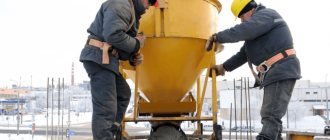Preparing mortar for brickwork in the summer is not difficult, and most of all masonry work is carried out in the warm season, completing the masonry before extreme cold. But there are situations when it is not possible to complete the entire volume of planned work on time, and masons are forced to finish the brickwork in the cold season.
In such extreme conditions, it is necessary to take into account the properties of the binders of the mortar and the freezing characteristics of the masonry mortar at temperatures below 0 degrees Celsius. The basis of the solution is water, which at sub-zero temperatures begins to freeze, which immediately turns the solution into an ice block.
To solve this problem and increase the binding properties of the masonry mortar, I add various chemical reagents to the solution, which accelerate the processes of cement hardening and increase the plasticity of the mortar.
Most often, the chemicals used are sodium nitrate, potassium carbonate and sodium chloride, but other chemical compounds are also possible. When adding chemical reagents to the solution, the air temperature should not be below 5 degrees Celsius. In addition, you cannot dilute the solution with reagents if it is already frozen or after it has recently been defrosted!
The described chemical reagents should be used only for certain types of masonry. Calcium and sodium chloride are used only for underground masonry, due to the fact that they contribute to the appearance of stains on the masonry seams.
The stains are white, which accordingly spoils the aesthetic appearance of the brickwork when these reagents are used for facing masonry. But this is not the main disadvantage of these reagents - if used excessively and disproportionately, the reagents contribute to the destruction of the brick. To obtain a high-quality mortar for bricklaying in winter, chemical reagents must be used in strict dosages!
Sometimes the process of building a building is very delayed; it continues after the arrival of cold weather.
But summer cement mixtures for construction consist of 3-4 main components, one of which is water, which becomes ice at negative temperatures. Therefore, special options for mortars for laying bricks in winter were invented. They contain additives that reduce the freezing point of water in the mixture.
The effect of frost on the solution
The hardening of the solution occurs due to the reaction between water and cement. As a result, a gel-like mass is created, which over time becomes a stone.
And the lower the temperature around, the slower the solidification process will occur. So, at a level of 5°C, this process will last 4 times slower than it would at 20°C. But when the mark reaches 0 °C, hardening stops altogether.
Negative temperatures negatively affect the structure, as well as the strength of future hardened cement.
In addition, the interaction between the two binder components stops completely, due to the fact that the water becomes ice. In addition, in solid form it increases in volume. This causes the solution to lose the strength it had before freezing.
Also, due to freezing, cement loses its elasticity significantly, due to which the compaction of horizontal joints in the masonry is insufficient.
In addition, after thawing, uneven settlement occurs, and this already threatens the strength of the structure being built. That is why it is recommended to use mortar for winter bricklaying. It is created by adding the required amount of special additives to the usual mixture, which impart frost-resistant properties.
Heat shield device
You can also heat brick walls from inside the room
This method is considered the most labor-intensive and quite expensive, but can be used if the brick building has small parameters. The essence of the method is to build protective shields around the proposed masonry. The distance from the shields to the lined walls should be approximately 10-15 cm.
You can also heat brick walls from inside the room. To do this, all openings in the built walls are completely closed, the roof is covered with a tarpaulin, and with the help of thermal electrical appliances installed inside the building, the temperature is raised to 40-50 degrees Celsius. Under such conditions, the solution will gain its technological strength even in severe frost.
This method requires additional labor and time. In addition, this is an additional consumption of electricity, which is another cost item in the construction estimate.
Cement-lime mixture
In the summer, when the outside temperatures are above zero, classic cement mortar is used to build walls or other types of brickwork. It is easy to prepare with your own hands from the following ingredients:
- Cement; Sand; Lime (may not be used at all in simpler mixtures).
First, a limestone dough is created.
It is made by mixing water with lime. Next, the resulting slurry is filtered using a fine sieve. Separately, but in parallel, a mixture consisting of sand and cement is mixed.
Next, the resulting limestone dough is poured into it, as well as the required volume of water and mixed until a homogeneous mass is created. It is with this mortar that bricks are held together in the summer. In cold times, things happen a little differently.
How to choose antifreeze additives
For construction work, you should choose only high-quality additives, which are distinguished by:
- Simple technology of use;
- Affordable price;
- Convenient packaging;
- Compliance with all requirements for the construction of buildings in winter.
These are the characteristics of the antifreeze additive Osnovit Safescreen SN1. These high-tech products have already stood the test of time. Osnovit was used in the creation of large sports and shopping complexes, such famous construction projects as Zaryadye Park and the VTB Ice Palace.
Mix for winter masonry
The winter solution differs from its summer counterpart only in certain additives. They allow you to reduce the level of freezing of the cement mixture, due to which it does not lose its state of aggregation and continues to harden. When the “summer” solution is ready, certain chemicals are added to it to impart the desired properties:
- Calcium chloride; Potash, also known as potassium carbonate; You can also use sodium nitrite.
The use of each of these substances has a specific effect on the mixture. But the goal is the same - to reduce the temperature when the water turns into a solid state.
The choice of substance for a particular case depends on the air temperature. Such additives are added to the solution during the mixing process immediately after pouring water. Due to this, it is possible to evenly distribute inclusions throughout the entire composition of the cement mixture and achieve the desired result.
However, after reading a recipe, you should not rush to implement it. Modifications of the solution do not always show the desired effect.
So, if you add salt to the mortar for laying bricks, this will lead to its subsidence. This situation has a very specific justification. When the brick mortar used for construction in winter contains a significant amount of salt, after the onset of positive temperatures, the wall will shrink and tilt.
The point here is not even the amount of salt added, but the very fact of its presence. When industrial additives, such as sodium chloride, are used, they are one of the components of the entire antifreeze mixture. Together they lead to a chemical reaction, due to which a new substance is formed, so they should not be perceived separately.
Rules
The construction of load-bearing walls and partitions is carried out according to similar principles:
Preparing the foundation.
The foundation is laid from the same material from which the walls are made or from concrete. The foundation must be strong and able to support the weight of the cinder block structure. Its surface is cleaned of unevenness and dust using a pick or spatula, and the debris is eliminated.- The base of the wall is waterproofed before starting masonry. The foundation is covered with a roll of waterproofing material, melted, and the joints are treated with bitumen mastic (roofing felt or membrane is used).
- The first row of walls should be at a height of at least 70 cm from the soil, since cinder block tends to absorb moisture. The foundation under such houses is built 40 cm wider than the wall and raised above ground level.
- Work with masonry is carried out on both sides of the wall. To avoid obstacles when bringing cinder blocks to the right place, you need to clear the path.
- The first row should protrude slightly beyond the base. In this case, when precipitation falls, it will roll down the surface of the wall onto the blind area and go through the storm drain. If the ledge is not made, they will accumulate on the resulting ledge and wash away the walls, which will lead to the destruction of the building material. The optimal thickness of the mortar joint is 1-2 cm; you can change it to adjust height differences or when using chipped material.
- Hollow cinder blocks are placed with the voids facing down so that the space inside is not clogged with mortar. In this case, a small amount of the connecting mixture should be present inside so that the blocks stick more tightly.
- To prevent the solution from falling out of the row, it is placed at a distance of 1 cm from the edges of the blocks. Then under pressure it will be distributed evenly.
- The laying is carried out in order, each row is shifted by ½ or ⅓ part relative to the previous one. This will make the wall stronger.
- Every 3-4 rows the seam is reinforced with mesh. Then the masonry will retain its strength for a long time, and the house will last for several decades.
- Solid blocks are used for door and window openings.
Many novice builders are interested in how many rows can be laid per day. To ensure that the solution has time to harden and the masonry retains its shape, it is not recommended to raise the wall higher than 1.5 meters per day . After each row, take a break of 2 hours so that the solution has time to gain hardness.
Application
There are not many rules when using mortar for laying bricks in winter, but you need to know them.
Otherwise, a building erected at sub-zero temperatures will sag or collapse completely after the onset of cold weather. First of all, the temperature of the solution during installation should not be lower than 5 °C. Once it has frozen, defrosting it again will no longer allow the creation of staples. This is due to the loss of its properties. The next rule for using a frost-resistant solution in winter is to add calcium carbonate.
It is prohibited to use this inclusion when laying silicate products. And in the case of using ceramic bricks, pay special attention to the quality of the masonry itself. This is due to the fact that such chemical additives retain the astringent properties of the solution used, but the performance is lower than in warm weather. Due to this, hardening takes longer, and the quality of the bonds created is lower.
Heating with electricity
The horizontal joints of the masonry are covered with wire with a thickness of 0.3 to 6 mm, which is then connected to a source of electricity and heated. In this case, it is necessary to properly fill the vertical seams, otherwise the heat transfer will occur very slowly.
Electricity consumption ranges from 95 to 180 kW * h m3. Heating the solution takes no more than 25% of the heat generated by the wiring. The rest of the heat goes to heating the brick itself, as well as the surrounding air. This method is not highly effective, although it is more practical and simpler than constructing greenhouses.
When using electric heating, the presence of a specialist is required who is able to select the correct electrode connection scheme and calculate their thickness (depending on the voltage of the power source and current strength).
Folk remedies
Some people add regular automotive antifreeze to the mortar to give it the desired properties. But after introducing it into the composition, it is necessary to constantly monitor the quality of hardening. Otherwise, the cement mortar will not harden correctly.
To do this, do-it-yourself winter brickwork must have a small number of nests in which plugs will be inserted. After their removal, it becomes possible to measure the temperature of the solution in this area. Due to this, the condition of the cement and hardening are monitored.
It is necessary to build walls when the masonry mixture for bricks is supplemented with antifreeze, carefully and taking the necessary precautions.
This is due to the fact that such inclusions belong to inorganic solvents, as well as mineral salts. Therefore, during the masonry process, workers must use protective clothing, gloves, and face and eye protection. Failure to comply with these measures results in chemical burns.
DIY construction technology
Let's consider where to start laying and how the subsequent stages of work occur:
- On the base of the building, beacons are placed in the corners, lines are marked where the walls will be laid. A mooring thread is pulled between them.
Be sure to check all corners; a height difference of no more than 3 cm is allowed. The difference can be compensated for by the thickness of the seam.When working in the hot season, cinder blocks are watered so that they do not absorb water from the solution. After finishing the work, continue to water for another 2 days until the joint mixture completely hardens.
- The installation process begins from the corners. The wall is raised 2-3 rows, the geometry is checked, and the mooring line is moved along with it a row higher. The first cinder block is placed on the solution.
- Subsequent rows are performed according to the same principle. During the work, it may turn out that some cinder blocks will not fit in size. In order to fit an element into the middle of the row, it will need to be cut according to the principle indicated above.
Learn about the basics of cinder block laying in this video:
Cinder block is sensitive to moisture; experienced builders recommend covering it with waterproofing, insulation and facing material after preparing the wall.
Read more about the technology of laying cinder blocks with your own hands here.
If you want to leave the masonry uncoated, the joints are unstitched.
How is jointing done?
A special feature of working with hollow blocks is the unusual jointing . For convenience, it is recommended to make templates that will fit a specific material. It makes no sense to lay the solution in a continuous layer, since it will simply fill the voids inside the material and will not perform a useful function. Therefore, they place it only on the part where the blocks are connected closely and vertically, in order to avoid waste of material.
For more details on wall paneling, watch the video:
Thawing winter masonry
When, after winter hardening, the mortar in the erected wall begins to thaw, a sharp loss of stability occurs.
And in the case of uneven thawing, it even leads to deformation of the wall. Due to this, it is important to control the process and carry out timely measures to maintain the stability of the erected structure. When the masonry is laid using the freezing method, during its thawing, they carefully monitor how it occurs. More attention is paid to the power elements on which the stability of the entire erected structure depends.
It is necessary to monitor the condition of the constructed masonry until the thawing ends, and constant above-zero temperatures set in. Due to the fact that the walls of the building, located on different sides, are not evenly heated by nature, it is recommended to cover the northern side with parchment. This will create equal conditions and a uniform thawing process Date: 01/09/2015 Comments: Rating: 26 Construction work is a rather labor-intensive process, but in winter it becomes more complicated. In order to make and use winter mortar for bricklaying, you need to know a number of features. Brickwork diagram.
Walls, floors and beams
When walls or pillars are erected, it is necessary to make masonry of the entire building, as a border, a seam may protrude, which is sedimentary. The height of the structure in such conditions should not be more than 4 m. When the masonry is ready, floor slabs must be placed on it immediately. All beams, as well as purlins that rest on the walls, must be connected using metal anchors.
The base for the foundation is laid out, protecting everything from freezing, both during and after work. This is necessary so that the foundation does not begin to rapidly sag during thawing, thereby subjecting the masonry to deformations that can lead to collapse. In winter, roofing felt, roofing felt, or polyethylene are laid on the plinths directly on a leveled concrete bed. They are laid in three layers, or more, the main thing is to contain the effects of frost.











